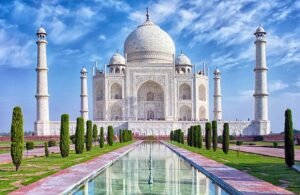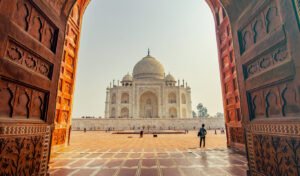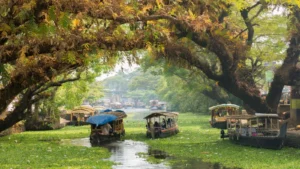


India is a land of contrasts. Towering Himalayan peaks, sun-drenched deserts, lush tropical coasts, ancient temples, bustling cities, and serene backwaters—this vast country is a kaleidoscope of landscapes, cultures, religions, languages, and history. For travelers in 2025, India remains one of the most compelling destinations in the world: endlessly varied, deeply spiritual, exhilarating, humbling, and full of surprises at every turn.
1. Planning Your India Journey: Practical Tips & Considerations
Before you set foot in India, it helps to prepare wisely. The sheer scale and diversity can overwhelm, so some planning is essential.
1.1 Visa, Entry & Regulations
Most nationalities require an e-Visa (India Online Visa) which can be applied for in advance. The process is generally straightforward but always check current rules because immigration policy can change. Be sure to have all required documents (passport valid for at least six months, return ticket, proof of funds). India also offers different categories of tourist visas (30-day, 1 year, or 5 years depending on your home country).
1.2 Best Time to Visit
Because of India’s diversity in climate zones, the “best time” depends on where you plan to go:
-
Northern India & Rajasthan: October to March offers cooler, pleasant weather. Summers (April–June) can be extremely hot, and monsoon (July–September) brings heavy rains.
-
Himalayan regions: May to September (post-snow, pre-winter) is ideal. Some passes are closed in winter.
-
South India & Kerala: December to March is the driest and most comfortable.
-
Northeast: October to May is safer; monsoon months (June to September) see heavy rains.
Given this, for a well-rounded trip across multiple zones, October to March is often recommended.
1.3 Health, Safety & Vaccinations
-
Consult a travel clinic well before departure: you may need vaccinations for hepatitis A & B, typhoid, and others depending on your itinerary.
-
Carry a basic medical kit and any prescription medicines (with prescriptions).
-
Food and water safety: stick to bottled or boiled water, avoid raw salads or street food unless you are confident. Use only cooked, hot food.
-
Dress modestly, especially in rural or conservative areas. Always carry sunscreen, mosquito repellent, and a hat.
-
Be cautious with personal belongings in crowded spaces. Use a money belt or hidden pouch.
1.4 Transport & Connectivity
-
India has a vast network of domestic flights. Booking ahead is wise.
-
Trains are iconic and a window into everyday India; sleeper class offers affordability and experience. The Indian Railways network is huge, but book well in advance (especially for long routes).
-
Road journeys: hiring a car with driver is common for intercity travel, especially in Rajasthan or Ladakh.
-
Local transport: autorickshaws, cycle rickshaws, metro in big cities, motorbikes, buses.
-
SIM cards are readily available; get a local data plan to stay connected.
1.5 Cultural Sensitivity & Etiquette
-
India is deeply religious. Remove shoes at temples, dress modestly, especially around holy places.
-
Ask permission before photographing people, especially in rural or tribal areas.
-
Be aware of cultural norms around gender, public behavior, and social customs.
-
Learn basic phrases (“namaste”, “thank you”, “ji”, “shukriya”) — small gestures go a long way.
1.6 Money & Costs
-
India is relatively affordable compared to many Western destinations, but costs vary widely.
-
Currency is the Indian Rupee (INR). Use ATMs in cities; carry some cash in remote areas.
-
Bargaining is common in markets (within reason). Fixed-price stores don’t allow haggling.
-
Tipping is expected in tourist services; 5–10% is standard in restaurants if service is good.
With these in mind, you’re ready to dive into the major destinations. Now, let’s explore the Best Places to Visit in India—destination by destination.
2. The Golden Triangle and Northern India
The “Golden Triangle” is the classic starter circuit for many travelers, linking Delhi, Agra, and Jaipur. But the continuum of Northern India stretches beyond, including historic cities, hill stations, and religious centers.
2.1 Golden Triangle: Delhi ➝ Agra ➝ Jaipur
Delhi
Delhi—the beating heart and gatekeeper of modern India—intertwines the ancient and the contemporary. In Old Delhi, walk through narrow lanes, visit Jama Masjid (one of India’s largest mosques), and stroll through Chandni Chowk market. Tour the Red Fort, Humayun’s Tomb (a forerunner of the Taj design), and Qutub Minar. In New Delhi, see India Gate, the Presidential Palace, Lotus Temple, and explore museums like the National Museum or the Crafts Museum. Lonely Planet+1
Delhi showcases both colonial legacy and the many centuries of Delhi Sultanate, Mughal, and modern eras. It is often your entry point and deserves at least two to three days.
Agra
Agra’s name is nearly synonymous with the Taj Mahal, one of the Best Places to Visit in India —arguably the most iconic. Built by Emperor Shah Jahan as a tomb for his wife Mumtaz Mahal, its symmetry, marble inlays, and ephemeral beauty at dawn and dusk draw visitors from across the globe. Lonely Planet+2Tripadvisor+2
Other attractions: Agra Fort, the Mehtab Bagh gardens across the Yamuna (for Taj views at sunset), and nearby Fatehpur Sikri (the abandoned Mughal capital) are essential add-ons. The Golden Triangle circuit connects seamlessly to this. Wikipedia+2The Palace on Wheels+2
Jaipur
From Agra, you can head west to Jaipur, the “Pink City” and capital of Rajasthan. Jaipur is famous for Hawa Mahal (Palace of Winds), Amber Fort, Jal Mahal, City Palace, and bustling bazaars of Jaipur (jewelry, textiles). The Times of India+3Lonely Planet+3The Times of India+3
In 2025, Jaipur has even gained recognition on the global stage: it recently beat Florence to enter the top 5 best cities in the world for travellers. The Times of India
The Golden Triangle (Delhi–Agra–Jaipur) is compact yet powerful, offering a taste of India’s architectural, cultural, and culinary richness. Wikipedia+1
Beyond the triangle, there are many more in North India.
2.2 Varanasi & Spiritual North
A few hours’ train ride east from Delhi, in Uttar Pradesh state, lies Varanasi, one of the world’s oldest living cities and a major spiritual center for Hindus. Its ghats (riverfront steps) along the Ganges host ritual bathing, evening Aarti ceremonies, and endless processions of devotion. The Kashi Vishwanath Temple, the narrow alleys, and the intensity of daily life here make Varanasi one of the Best Places to Visit in India for those seeking spiritual depth. India Travel Forum+4The Times of India+4Travelogy India+4
Nearby Sarnath (where Buddha first preached) is a short excursion, adding Buddhist heritage to your spiritual circuit.
2.3 Fatehpur Sikri, Agra Surroundings
Though often just a detour from Agra, Fatehpur Sikri merits its own spotlight. This red sandstone, partially abandoned Mughal city is a UNESCO site. Its Buland Darwaza gate, Jodha Bai’s palace, Panch Mahal, and various courtyards offer glimpses of Mughal urban planning, ambition, and eventually overreach (the city was abandoned due to water issues). Visiting Fatehpur Sikri deepens your historical context of Agra and the Mughal period.
2.4 Additional Northern Highlights
-
Ranthambore National Park (Rajasthan) for tiger safari. MakeMyTrip+2TravelTriangle.com+2
-
Ajmer & Pushkar: pilgrimage town and desert town respectively, with Pushkar’s Brahma temple and the famous Pushkar Camel Fair. TravelTriangle.com
-
Gwalior, Orchha, Khajuraho: north-central India, offering forts, palaces, and erotic temples. Khajuraho is UNESCO-listed. MakeMyTrip+2Travelogy India+2
-
Rishikesh & Haridwar: gateway to Himalayan pilgrimage, yoga, river rafting, temples along the Ganges. MakeMyTrip+1
-
Nainital (Uttarakhand): a hill station in the Kumaon region featuring scenic lakes and cool climates. MakeMyTrip+1
-
Devasthal Observatory (Nainital district): for astronomy buffs, the Devasthal site hosts 1.3 m, 3.6 m, and 4 m telescopes under good seeing conditions. arXiv
This covers much of Northern India’s core. Next, let’s ascend into the Himalayas.
3. Himalayan Escapes: Ladakh, Spiti & Uttarakhand
For many, the draw of India lies not just in its culture and heritage, but in its raw natural beauty and high-altitude frontier. The Himalayan belt offers some of the world’s most dramatic and spiritual landscapes.
3.1 Ladakh & Zanskar
Ladakh, often called “Little Tibet,” lies in India’s far north (union territory of Ladakh). Visiting Ladakh is often cited as one of the Best Places to Visit in India for adventure travellers. Travelogy India+3Travel and Leisure Asia+3Lonely Planet+3
-
Leh is the hub: Leh Palace, Shanti Stupa, monasteries like Thiksey and Hemis.
-
Pangong Tso (lake) and Tso Moriri are stunning high-altitude lakes with indigo waters and barren surroundings.
-
Nubra Valley, Sham Valley, Zanskar Valley (for trekking).
-
Crossing Khardung La (one of the highest motorable passes) is a rite of passage.
-
In winter many parts are closed due to snow, so summer is prime season.
Ladakh is also evolving in terms of sustainable tourism, and the challenge is balancing high-volume visits with fragile ecology.
3.2 Spiti Valley
East of Ladakh, Spiti Valley in Himachal Pradesh is a trans-Himalayan desert with dramatic vistas, Buddhist monasteries, and minimal human footprints. In May–June, passes open and the valley becomes accessible. The Palace on Wheels+1
Key stops: Kaza, Key Monastery, Chandratal Lake, Pin Valley, Trilokinath, and remote villages. Spiti’s arid landscapes, night skies, and soul-calming atmosphere make it one of the Best Places to Visit in India for offbeat adventure seekers.
3.3 Uttarakhand: Garhwal & Kumaon
Uttarakhand, the “Land of the Gods,” is dotted with pilgrimage, forest, alpine, and spiritual destinations.
-
Rishikesh: yoga, spirituality, river rafting, ashrams.
-
Haridwar: one of the holiest cities on the Ganges, with evening Ganga Aarti.
-
Valley of Flowers National Park (endemic alpine blooms).
-
Nainital, Almora, Mussoorie (cherished hill stations).
-
Ananda in the Himalayas, a luxury spa retreat set in a palace overlooking the Ganges, blends wellness and royal ambience. Wikipedia
These Himalayan escapes offer respite from crowd, spiritual rejuvenation, and nature’s theater.
4. Spiritual Heartlands: Varanasi, Rishikesh, Bodh Gaya
While much of India’s appeal lies in its physical beauty, perhaps its deepest draw is spiritual. Some cities vibrate with devotional energy, and many travelers visit India precisely on pilgrimage or inner search.
4.1 Varanasi Revisited
As earlier mentioned, Varanasi (Banaras, Kashi) is one of the Best Places to Visit in India for spiritual immersion. The Ganges ghats host daily rituals, theater of life and death, Hindu cremations, and devotion at every hour. Lonely Planet+3The Times of India+3TravelTriangle.com+3
Book a dawn boat ride, attend evening Aarti, wander the alleys, visit local temples, and witness life in raw form.
4.2 Rishikesh & Haridwar
Rishikesh is often called the “Yoga Capital of the World.” It bridges the worldly and spiritual, offering yoga retreats, meditation, and adventure. MakeMyTrip+1
Haridwar, nearby, is one of the seven holiest places in Hinduism (Sapta Puri). The Ganga Aarti in Har Ki Pauri is a grand spectacle. Many pilgrims commence or conclude Himalayan treks from here.
4.3 Bodh Gaya
In the heart of Bihar lies Bodh Gaya, the place where Prince Siddhartha attained enlightenment under the Bodhi Tree and became the Buddha. The Mahabodhi Temple, the Bodhi Tree (descendant of the original), and monasteries from around the world make Bodh Gaya a major pilgrimage site for Buddhists globally.
Pair Bodh Gaya with nearby Nalanda (ancient university ruins) and Rajgir Hills (ancient spiritual site) to deepen your understanding of India’s Buddhist heritage. TravelTriangle.com+2Travelogy India+2
This spiritual triangle—Varanasi, Rishikesh, Bodh Gaya—connects Hindu and Buddhist threads of India.
5. The Desert Kingdoms and Royal Rajasthan
No picture of India is complete without the vivid colors, regal palaces, and desert landscapes of Rajasthan. This is where the vision of India in postcards and dreams often originates.
5.1 Jodhpur, Jaisalmer, Udaipur
-
Jodhpur (“Blue City”) houses the massive Mehrangarh Fort, Jaswant Thada, and sprawling bazaars. MakeMyTrip+1
-
Jaisalmer (“Golden City”) lies in the Thar Desert. Its sandstone fort, havelis (mansions), desert camps, and camel safaris encapsulate desert romance. The Lodhurva Jain Temple near Jaisalmer is another site worth a detour. Hippie In Heels+1
-
Udaipur (“City of Lakes”) is romantic and lush compared to desert surroundings. Its palaces (Lake Palace, City Palace), temples, and scenic lakes make it a favorite.
5.2 Pushkar, Ajmer & Chittorgarh
-
Pushkar: a small, holy town with 52 ghats around Pushkar Lake and the rare Brahma Temple. The annual Pushkar Camel Fair is legendary. TravelTriangle.com
-
Ajmer: pilgrimage town for Muslims and Hindus (Ajmer Sharif Dargah).
-
Chittorgarh: once capital of Mewar, with massive fortress, palaces, and tragic history of queen martyrdom. TravelTriangle.com
5.3 Desert Safari & Wildlife
-
Ranthambore National Park is a hotspot for tiger sightings near Jaipur/Agra circuit.
-
Desert Camps: spending a night under stars, around bonfires, in traditional folk tents is quintessential Rajasthan.
-
Shekhawati region: towns like Mandawa and Fatehpur with painted havelis (frescos) are lesser-known but visually beautiful.
In Rajasthan, you experience history, art, folk culture, and the raw force of the desert—making it a centerpiece among the Best Places to Visit in India.
6. South India: Kerala, Tamil Nadu, Karnataka
Crossing from north to south is like stepping into a wholly new world: tropical climate, coconut groves, temple traditions, spice trails, backwaters, and classical dance forms.
6.1 Kerala: God’s Own Country
Kerala is often a traveler’s favorite in India, and for good reason. Its pace is gentler, nature more humid and luxuriant, with a strong cultural identity. Travel and Leisure Asia+1
Backwaters & Houseboats
Cruising the backwaters in Alleppey (Alappuzha) or Kumarakom is nearly a rite of passage. Slowly glide through canals and paddy landscapes, past coconut palms and rural life. The Times of India
Hill Stations & Tea Country
Munnar is famous for tea plantations, rolling hills, and cool climate.
Wayanad and Thekkady bring spice plantations, wildlife, and trekking.
Culture & Festivals
Kathakali, traditional dance and theater, Ayurveda treatments, and festivals such as Onam enrich your experience.
Kochi (Cochin)
Historic port city of Kochi blends colonial, Jewish, Chinese, and local traditions. Explore Fort Kochi, Mattancherry, Chinese fishing nets, Dutch Palace, and Parades.
6.2 Tamil Nadu & South India’s Temple Trail
In Tamil Nadu, temple architecture reaches its peak. The Meenakshi Temple at Madurai, Brihadeeswara Temple in Thanjavur, and the Shore Temple in Mahabalipuram are masterworks of Dravidian art.
Tamil Nadu also offers nature escapes: Kodaikanal, Ooty, Coimbatore, and hill country in the Western Ghats.
6.3 Karnataka & Hampi
Karnataka is diverse—Bengaluru (garden city), Mysore, Hampi, Coorg, and the coastline.
Hampi is a surreal landscape of giant boulders, ruined temple complexes, and poetic archaeology. It’s often described as one of the most evocative places in India. Hippie In Heels
Historic temples, rivers, cave shrines, and rural simplicity make Karnataka a rewarding corridor.
7. East & Northeast India: Darjeeling, Meghalaya, Assam
India’s northeastern states are less visited but immensely compelling: misty hills, tribal cultures, unique biodiversity, and still a sense of frontier.
7.1 Darjeeling, Sikkim & the Eastern Himalaya
Darjeeling, perched in West Bengal, is the “Queen of the Hills.” It offers views of Kanchenjunga, tea estates, the Darjeeling Himalayan Railway (toy train), monasteries, and a serene colonial charm. Lonely Planet+2MakeMyTrip+2
Sikkim: the Buddhist monasteries of Gangtok, Tsomgo Lake, and high-altitude treks.
7.2 Meghalaya: Abode of Clouds
Meghalaya, literally the “abode of clouds,” is famed for its misty landscapes, waterfalls, caves, and living root bridges (in Cherrapunji and Mawlynnong). Shillong is the capital city and a cultural hub. In 2025, Shillong has become India’s most-searched destination, surpassing Goa in traveler interest. The Times of India
7.3 Assam & Wildlife
Assam is home to Kaziranga National Park, which protects much of the world’s remaining one-horned rhinoceros population. The Times of India
Other sanctuaries like Manas, Pobitora, and Nameri offer birdlife, elephants, rare mammals, and a chance to see India’s biodiversity up close.
These states offer a deeply different India—lush, green, mist-wrapped, and culturally distinct from mainstream India’s imagery.
8. Islands & Coastal Paradises: Andaman, Lakshadweep, Goa
Beyond the mainland, India’s islands and coastline offer another dimension: turquoise seas, coral reefs, palm-fringed beaches, and marine wonder.
8.1 Andaman & Nicobar Islands
Remote yet accessible, the Andaman Islands harbor some of India’s best beaches, underwater life, and forest ecosystems. Radhanagar Beach on Havelock Island (Swaraj Dweep) is internationally recognized; it has a Blue Flag certification for sustainability and is among top beaches globally. Wikipedia
Snorkeling, scuba diving, sea caves, and forest treks are among the highlights.
8.2 Lakshadweep
Lakshadweep is India’s coral atoll cluster in the Arabian Sea. It’s still less commercialized, offering serenity, coconut palms, lagoon dives, and marine life.
8.3 Goa
Goa is among the most popular coastal destinations in India. Its sandy beaches, nightlife, Portuguese heritage, seafood, and coastal villages make it a favorite. In October, Goa is among the top picks for India travel. MakeMyTrip
Whether you want beach parties, yoga retreats, or rustic hamlets, Goa has many faces.
8.4 Other Coastal Gems
-
Gokarna (Karnataka): quieter counterpart to Goa.
-
Pondicherry (Puducherry): French colonial vibe meets Tamil culture.
-
Konark (Odisha): Sun Temple and beach scenes.
-
Kanyakumari (Tamil Nadu): where three seas meet, sunrise and sunsets on the ocean.
9. Wildlife & Nature: National Parks & Sanctuaries
India’s biodiversity is vast—ranging from snow leopards in the Himalayas to tigers in central India to rhinos in Assam to marine ecosystems. If you love nature, these are must-visits.
9.1 Tiger Reserves & Big Cats
-
Ranthambore (Rajasthan)
-
Jim Corbett (Uttarakhand)
-
Kanha, Bandhavgarh, Pench (Madhya Pradesh)
-
Kaziranga, Manas (Assam)
These parks offer safaris (jeep, elephant, walking) and a chance to see tigers, leopards, deer, wild boar, and myriad bird species.
9.2 Elephants, Rhinos & Rare Species
-
Kaziranga: rhino, elephants, swamp deer.
-
Silent Valley (Kerala), Periyar (Kerala), Wayanad and Bandipur (Karnataka) for elephants, primates, and rich forest life.
9.3 Alpine & High-Altitude Wilderness
-
Spiti, Ladakh, Zanskar: snow leopard territory, high lakes, rugged terrain.
-
Valley of Flowers (Uttarakhand): subalpine meadows and Himalayan flora.
-
Great Himalayan National Park (Himachal Pradesh) protecting Himalayan fauna. The Times of India
9.4 Marine & Coastal Ecology
-
Coral reefs around Andaman & Lakshadweep
-
Marine sanctuaries (Gulf of Mannar, Gulf of Kutch)
-
Mangroves in Sundarbans (West Bengal), the largest tiger-inhabited mangrove ecosystem.
For nature lovers, India offers a wide palette of eco-experiences, often tied to remote treks, boat rides, or night safaris.
10. Offbeat Trails & Hidden Gems
Beyond the well-worn routes lie lesser-charted paths that often reward the curious traveler.
10.1 Offbeat in Rajasthan & Desert
-
Shekhawati Painted Havelis (Mandawa, Nawalgarh)
-
Osian desert temples
-
Ramgarh crater
-
Tirthan Valley (Himachal Pradesh)
-
Chopta & Deoriatal (Uttarakhand)
10.2 Northeast & Tribal Regions
-
Ziro Valley (Arunachal Pradesh)
-
Tawang (Arunachal Pradesh)
-
Dzukou Valley (Manipur-Nagaland border)
-
Garo Hills & Khasi Hills (Meghalaya)
-
Dooars & Buxa (West Bengal)
10.3 Hill Stations & Lesser-Known Towns
-
Valley of Flowers
-
Ladakh’s remote villages: Turtuk, Darcha
-
Kinnaur & Spiti border villages
-
Chikmagalur & Coorg (Western Ghats)
-
Hampi’s hinterlands and hidden temples
10.4 Cultural & Historical Surprises
-
Bhimbetka rock shelters (Madhya Pradesh) with prehistoric cave art
-
Ellora & Ajanta caves
-
Sanchi Stupa
-
Majuli island (Assam): world’s largest river island and Vaishnavite culture
-
Rajasthan’s Bikaner, Bundi, Patan, Sheoganj
These offbeat paths often require flexibility, local permits, and patience—but bring great reward in solitude and authenticity.
11. Sample Itineraries & Travel Strategy
Depending on how much time you have and your interests, here are sample itineraries:
11.1 Two-Week Classic India Sample
Day 1–3: Delhi
Day 4: Agra + Fatehpur Sikri
Day 5–7: Jaipur & surrounding forts
Day 8–9: Udaipur / Pushkar
Day 10–12: Jodhpur & Jaisalmer (desert camp night)
Day 13–14: Fly or train to Mumbai / Goa or north to Delhi
This is a whirlwind but covers core Rajasthan + Golden Triangle.
11.2 Four-Week Immersion
-
Week 1: Delhi → Agra → Varanasi → Bodh Gaya
-
Week 2: Rajasthan circuit (Jaipur, Udaipur, Jodhpur, Jaisalmer)
-
Week 3: Goa → South India circuit (Kerala, Tamil Nadu, Karnataka)
-
Week 4: Himalayas (Uttarakhand / Spiti / Ladakh) or Northeast extension
This gives you a balanced taste across climate, region, and theme.
11.3 Specialist Itinerary: Spiritual & Nature
-
Rishikesh & Haridwar → Varanasi → Bodh Gaya → Sikkim → Meghalaya → Andaman
-
Add national parks and hill treks in between
11.4 Travel Strategy Tips
-
Use internal flights to cover long distances (e.g. Delhi to Guwahati, Guwahati to Port Blair)
-
Always keep buffer days: train delays, weather closures, local festivals
-
Use local guides in remote regions
-
Mix classic and offbeat: while Taj is essential, don’t skip that rural temple or mountain village
-
Respect local customs and seasonal constraints
Internal Link: For a travel lover’s perspective more broadly, check out this guide on Zimbabwe: Best Places to Visit in Zimbabwe
(This shows how a regional travel blog can shape detailed itineraries and might inspire cross-continental comparisons.)
12. Further Study, Reading & References
To deepen your knowledge, here are suggestions:
-
Read “In an Antique Land” by Amitav Ghosh or “India: A Million Mutinies Now”
-
Explore Indian history via A History of India by Romila Thapar
-
For spiritual perspective, Autobiography of a Yogi by Paramahansa Yogananda
-
Ecological & wildlife: The Song of the Scorpions by Chitra Divakaruni, or national park official publications
-
Literary travelogues like “Seven Years in Tibet”, “From the Holy Mountain”, or contemporary blogs
Use reliable sources: official tourism sites, UNESCO, academic journals, and local travel forums.
Conclusion
“Best Places to Visit in India” is not just about ticking landmarks off a list—it’s about threading together meaningful experiences: sunrise over the Taj, Buddhist chants in Spiti, a night in the Thar Desert under a million stars, quiet backwater drift in Kerala, or echoing footsteps in Himalayan trails.
India rewards those with patience, openness, and curiosity. Its contrasts are sharp. Its rhythms unpredictable. But for those who venture beyond, the country reveals itself layer by layer: in food, in devotion, in silence and noise, in fragility and resilience.
May your journey through India in 2025 be one of wonder, transformation, and stories worth telling.


